It’s an oft-commented fact that once a place has been sanctified by the erection of a religious building it tends to remain sacred even if the dominant religion changes. So in the East End of London it’s possible to come across the odd building that has served in turn as a church, a synagogue and then a mosque, its interior being adapted over the centuries to suit the needs of the changing local congregation.
Less frequently mentioned is the dedication that is sometimes devoted to keeping a particular site sanctified even when common sense would appear to suggest that it should be abandoned. In İstanbul, for example, there are many churches and mosques whose history is a litany of building and rebuilding as the original structures were written off by successive fires and earthquakes.
The same is true all over the country, actually. Not a lot of overseas visitors make it to Kocaeli (İzmit), the industrial city just to the east of İstanbul that, these days, is little more than an extension of the metropolis. I, too, normally whiz past on my way to the bright lights but on a recent visit I found myself standing thoughtfully in front of the Mehmet Bey Cami, AKA the Fevziye Cami, that is a town-centre landmark.
The Fevziye is a conspicuous if unflashy building with, behind it, the fish market, the Modernist Halkevi, and a rather unexpected memorial to the more than 23,000 Turks from Greece who were resettled here between 1923 and 1925 following the population exchange. But what had really caught my imagination on this occasion was the plaque summarising the mosque’s history.
One look at this and I realised what a miracle it was that the Fevziye should be here at all. The plaque listed a total of six buildings that had stood on this same site, starting with a Sinan mosque commissioned in 1576 by Süleyman the Magnificent’s famous Grand Vizier, Rüstem Paşa, in memory of the eponymous Mehmet Bey. At that time İzmit was the second place after Gebze where sultans would break a journey east from İstanbul, and as such it was graced with not one but two mosques by the great Sinan (the second still survives a little further up the road).
The Sinan mosque on this particular site was brought down by a massive earthquake in 1719. Rebuilt in 1721, it was then burnt down in 1757 in a pattern of alternating quake and fire damage that is reproduced time and time again across Anatolia. Rebuilt by Hacı Halal Ağa, it burnt to the ground again in 1837 after which one might have thought that even the most optimistic local might have wondered if fate was trying to tell them something. But, no, up stepped Admiral Ahmed Fevzi Paşa after whom the mosque was renamed after he had paid for it to be rebuilt all over again.
In 1894 a huge earthquake struck the area and the new-model mosque was rendered so dangerous that it had to be demolished, only to arise again like a phoenix in 1897. Then almost a century later disaster once again struck this unlucky building. On 17 August 1999 the Marmara earthquake ripped through İzmit and shattered the mosque. Down came the minaret. The roof and walls were left in so parlous a condition that they had to be demolished three years later.
But even as that decision was being made the authorities in Bursa were promising that the mosque would rise yet again. So it came to pass that in 2004 the Fevziye reopened for prayers for the sixth time. For lovers of fine architecture the surviving Sinan mosque down the road may be far more beautiful, but, boy, has a lot of effort been put into ensuring that this spot remains hallowed ground.
Written: 3 May 2013

